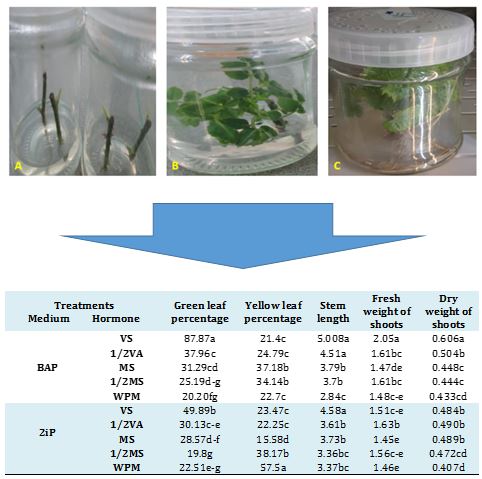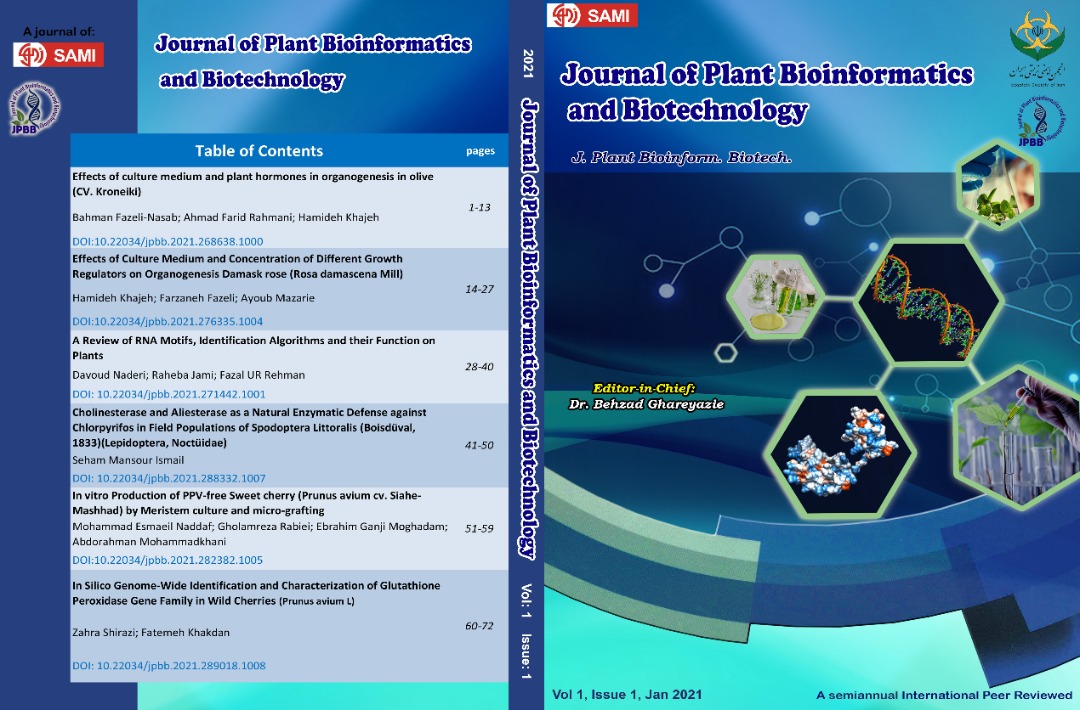1. Ahmadi Y, Khosh-Khui M, Salehi H, Eshghi S, Kamgar-Haghighi A A, Karami A. (2019). Effect of Salinity Stress on Growth and Biochemical Characteristics of Three Population of Damask Rose of Iran. Iranian Journal of Horticultural Science and Technology, 20(1): 89-98.
2. Gorji-Chakespari A, Nikbakht A M, Sefidkon F, Ghasemi-Varnamkhasti M, Valero E L. (2017). Classification of essential oil composition in Rosa damascena Mill. genotypes using an electronic nose. Journal of Applied Research on Medicinal and Aromatic Plants, 4: 27-34. https://doi.org/10.1016/j.jarmap.2016.07.004
3. Efferth T. (2019). Biotechnology applications of plant callus cultures. Engineering, 5(1): 50-59. https://doi.org/10.1016/j.eng.2018.11.006
4. De S. (2021). Strategies of plant biotechnology to meet the increasing demand of food and nutrition in India. International Annals of Science, 10(1): 7-15. https://doi.org/10.21467/ias.10.1.7-15
5. Fazeli-Nasab B, Masour O, Mehdi A. (2012). Estimate of callus induction and volume immature and mature embryo culture and respons to in vitro salt resistance in presence of NaCL and ABA in salt tolerant wheat cultivars. Intern. Agricult. Crop Sci, 4(1): 8-16.
6. Fazelienasab B, Omidi M, Amiritokaldani M. (2004). Effects of abscisic acid on callus induction and regeneration of different wheat cultivars to mature embryo culture. News directions for a diverse planet: Proceedings of the 4th International Brisbane, Australia, 26.
7. Espinosa-Leal C A, Puente-Garza C A, García-Lara S. (2018). In vitro plant tissue culture: means for production of biological active compounds. Planta, 248(1): 1-18. https://doi.org/10.1007/s00425-018-2910-1
8. Govinden-Soulange J, Boodia N, Dussooa C, Gunowa R, Deensah S, Facknath S, Rajkomar B. (2009). Vegetative propagation and tissue culture regeneration of Hibiscus sabdariffa L.(Roselle). World Journal of Agricultural Sciences, 5(5): 651-661.
9. Phuong V T B, Dai C M, Hong P T A, Phuong Q N D. (2018). Biological activity and hairy roots induction of Hibiscus sabdariffa L. Science and Technology Development Journal-Natural Sciences, 2(6): 66-74. https://doi.org/10.32508/stdjns.v2i6.845
10. Tapia M d L, Arbizu C, Beraún F, Lorenzo J, Escalona M. (2018). Pre-basic seed potato (
Solanum tuberosum L.) production using temporary immersion bioreactors.
Peruvian Journal of Agronomy, 2(1): 9-14.
http://dx.doi.org/10.21704/pja.v2i1.1127
11. Vinter M, Fedorovitch S, Karpushina M, Gridnev S. (2020). Micropropagation of rootstocks of stone fruit cultures in vitro. Paper presented at the BIO Web of Conferences. https://doi.org/10.1051/bioconf/20202505001
12. Moradian M, Bagheri A R, S.H. M, S.H. N, A. S. (2019). Effect of media composition and plant growth regulators on in vitro regeneration of Rosa canina and Rosa beggeriana. Journal of Plant Research (Iranian Journal Of Biology), 32(1): 155-165.
13. Imani M, Hoseini Nasr S M, Hatam J, Jalilvand H. (2018). Effect of Different Media on Some Morphological Characteristics of Acacia victoria Benth. In Vitro Conditions. [Research]. Ecology of Iranian Forests, 6(11): 31-40. https://doi.org/10.29252/ifej.6.11.31
14. Eghbali Shrjini P, Farokhzad A, Hosseini B H. (2018). Effect of culture medium, type and concentration of carbon source on the proliferation of Gisela 6 rootstock. Research in Pomology, 3(2): 1-15.
15. Bolandi A R, Hamidi H, Rezagholy A A. (2016). Effects of culture media and growth regulators on propagation of rootstock GF677 in tissue culture conditions. Journal of Plant Research (Iranian Journal Of Biology), 29(1): 1-14.
16. Saadat Y, Rasti O, Zamani J. (2012). Effects of different growth regulators, nutrient media, gelling agents and carbohydrate sources on shoot multiplication of Pyrus glabra Boiss. Iranian Journal of Rangelands and Forests Plant Breeding and Genetic Research, 20(1): 83-96. https://doi.org/10.22092/ijrfpbgr.2012.6565
17. Christensen B, Sriskandarajah S, Serek M, Müller R. (2008). In vitro culture of Hibiscus rosa-sinensis L.: influence of iron, calcium and BAP on establishment and multiplication. Plant cell, tissue and organ culture, 93(2): 151-161. https://doi.org/10.1007/s11240-008-9354-4
18. Shibli R A, Mohammad M J, Ajlouni Z I. (2002). Growth and micronutrient acquisition of in vitro grown bitter almond and sour orange in response to iron concentration from different iron chelates. Journal of Plant Nutrition, 25(7): 1599-1606. https://doi.org/10.1081/PLN-120005410
19. Van der Salm T P, Van der Toorn C J, ten Cate C H H, Dubois L A, De Vries D P, Dons H J. (1994). Importance of the iron chelate formula for micropropagation of Rosa hybrida L.‘Moneyway’. Plant cell, tissue and organ culture, 37(1): 73-77. https://doi.org/10.1007/BF00048120
20. Feizi F, Mousavi M, Chehrazi M. (2015). Micropropagation of Hibiscus rosa-sinensis through tissue culture. Applied Crop Breeding, 3(2): 191-200.
21. Bayanati M, Mortazavi S N. (2013). Micropropagation from cultured nodal explants of Rosa hybrida cv’Black Baccara’. International Journal of Agronomy and Plant Production, 4(6): 1381-1385.
22. Zarei M, Garoosi G, Nezami E, Hosseini R, Ahmadi J. (2013). The Effect of Medium, Carbon Source, Light Spectrum and Style Treatment of Auxin on Shoot and Root Regeneration of Gisela 6 Root Stock. Journal of Cell & Tissue, 4(2): 169-185.
23. Fathi Amirkhiz K, Amini Dehaghi M, Heshmati S. (2015). Study the effect of iron chelate on Chlorophyll content, Photochemical efficiency and some biochemical traits in Safflower under deficit irrigation condition. Iranian Journal of Field Crop Science, 46(1): 137-145. https://doi.org/10.22059/ijfcs.2015.54053
24. Jalil Shesh Bahre M, Movahedi Dehnavi M. (2012). Effect of zinc and iron foliar application on soybesn seed vigour grown under drought stress. Journal of Crop Production, 5(1): 19-35.
25. Xin C, Qing-wei Y, Jia-lin S, Shuang X, Fu-chun X, Ya-jun C. (2014). Research progress on nitrogen use and plant growth. Journal of Northeast Agricultural University (English Edition), 21(2): 68-74. https://doi.org/10.1016/S1006-8104(14)60036-2
26. Safarnejad A, Alamdari S B L, Darroudi H, Dalir M. (2016). The effect of growth regulators (BAP and IBA) on regeneration, proliferation and rooting of Natanz pears plant using in vitro technique. Iranian Journal of Plant Biology, 8(29): 77-90. https://doi.org/10.22108/ijpb.2016.21037
27. Hajian S, Alizadeh Ajirlo S, ZaareNahandi F. (2015). Effects of BAP and TIBA on Shoot Proliferation of Rosa hybrida L. cv. Full House in in vitro Culture. Journal Of Horticultural Science, 29(1): 111-118. https://doi.org/10.22067/jhorts4.v0i0.25304
28. Ho W-J, Vasil I K. (1983). Somatic embryogenesis in sugarcane (Saccharum officinarum L.) I. The morphology and physiology of callus formation and the ontogeny of somatic embryos. Protoplasma, 118(3): 169-180. https://doi.org/10.1007/BF01281800
29. Daffalla H H, Abdellatef E, Elhadi E A, Khalafalla M M. (2011). Effect of growth regulators on in vitro morphogenic response of Boscia senegalensis (Pers.) Lam. Poir. using mature zygotic embryos explants. Biotechnology research international, 2011: Article ID: 710758. https://doi.org/10.4061/2011/710758
30. Heydarpour-Monfared A, Kiadaliri H, Jaferyan E, Drikvandi A. (2013). The effect of Indolebutyric acid and the cutting time on rooting of Myrtus Communis L. Journal of Renewable Natural Resources Research, 4(1): 1-8.
31. Sabatini S, Beis D, Wolkenfelt H, Murfett J, Guilfoyle T, Malamy J, Benfey P, Leyser O, Bechtold N, Weisbeek P. (1999). An auxin-dependent distal organizer of pattern and polarity in the Arabidopsis root. Cell, 99(5): 463-472. https://doi.org/10.1016/S0092-8674(00)81535-4
32. Blakesley D, Chaldecott M. (1993). The role of endogenous auxin in root initiation. Plant Growth Regulation, 13(1): 77-84. https://doi.org/10.1007/BF00207595
33. Mansseri-Lamrioui A, Louerguioui A, Bonaly J, Yakoub-Bougdal S, Allili N, Gana-Kebbouche S. (2011). Proliferation and rooting of wild cherry: The influence of cytokinin and auxin types and their concentration. African Journal of Biotechnology, 10(43): 8613-8624. https://doi.org/10.5897/AJB11.450
34. Garoosi G A, Maleki S, Nezami-Alanagh E. (2018). Improvement of culture media and PGRs in Pistacia vera cv. Ghazvini micropropagation. Journal of Plant Research (Iranian Journal Of Biology), 31(2): 383-395.
35. Shojaiee K, Ganji Moghadam E, Jajarmi V. (2018). Investigation effects of culture media and growth regulators concentration on proliferation and rooting of Rosa damascena Mill cv " Kashan 2. Journal of Medicinal Plants Biotechnology, 4(First): 28-36.
36. Babaei H, Zarei H, Hemmati K. (2015). The Effect of Different Concentrations of IBA, Type of Plant Rootstock and Timeing of Cuttings on Propagation of Ficus benjamina CV. Variegata by Cutting - Graft. [Research]. Journal of Crop production and processing, 5(17): 253-261. https://doi.org/10.18869/acadpub.jcpp.5.17.253
37. Tien L, Chac L, Oanh L, Ly P, Sau H, Hung N, Thanh V, Doudkin R, Thinh B. (2020). Effect of auxins (IAA, IBA and NAA) on clonal propagation of Solanum procumbens stem cuttings. Plant Cell Biotechnology and Molecular Biology, 21(55&56): 113-120.
38. Sharma U, Kataria V, Shekhawat N. (2018). Aeroponics for adventitious rhizogenesis in evergreen haloxeric tree Tamarix aphylla (L.) Karst.: Influence of exogenous auxins and cutting type. Physiology and Molecular Biology of Plants, 24(1): 167-174. https://doi.org/10.1007/s12298-017-0493-0
39. Al Gethami F R, El Sayed H E S A. (2020). In vitro: Influence of Various Concentrations of Plant Growth Regulators (BAP & NAA) and Sucrose on Regeneration of Chenopodium quinoa Willd. Plant. Asian Journal of Biology, 9(4): 34-43. Article no: AJOB.60238; https://doi.org/10.9734/ajob/2020/v9i430095
40. Rahimi E. (2019). Rooting and shoot growth of soft-wood cutting of rubber fig (Ficus elastica Roxb. ex Hornem) in response to indole butyric acid and paclobutrazol. Journal of Plant Research (Iranian Journal Of Biology), 31(4): 972-982.


